

Although the patient was in good health, there were diminished breath sounds in the lungs. There was no evidence of TB. On chest x-ray, there were infiltrative, nodular, and cavitating lesions. A routine O&P examination revealed eggs seen below:
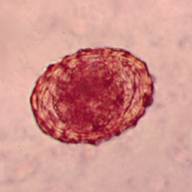 |
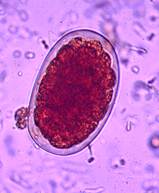 |
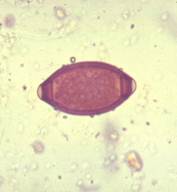 |
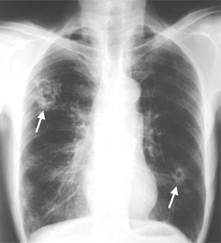
Scroll Down for Answer and Discussion
Answer and Discussion of Quiz #68
The images presented in Diagnostic Quiz #68 represent (left to right) an Ascaris lumbricoides fertilized egg (note the bumpy shell), a hookworm egg, and a Trichuris trichiura egg.
Answers to Questions:
These helminths belong to the nematode (roundworm) group. Since they are pathogens, the patient should be treated.
Since Ascaris and Trichuris eggs are acquired from the ingestion of contaminated soil containing infective eggs, often these two infections are seen in the same patient.
However, these helminth infections do not explain the patient’s symptoms and x-ray findings, particularly considering her history of ingesting raw or boiled fresh water crayfish. One would have to consider paragonimiasis; microscopic sputum exams for the typical eggs would be recommended. Also, additional stool exams for swallowed Paragonimus eggs should also be performed. Sputum examinations revealed the following typical eggs – additional case images are shown.
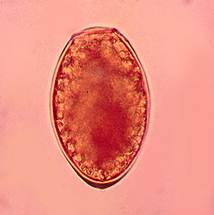 |
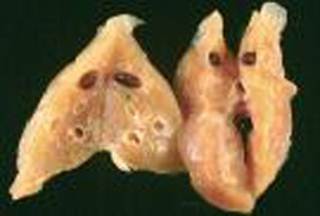 |
| Paragonimus egg | Adult flukes in lung tissue |
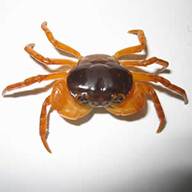 |
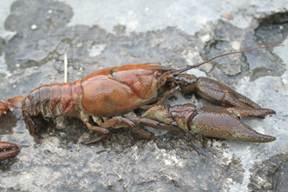 |
Comments on Diagnostic Methods:
Diagnosis is confirmed by either detection of eggs in sputum, stool, or gastric aspirate specimens or serologic test results. The serologic assays are available in areas of endemicity or in specialized diagnostic centers. Most of these assays involve nonstandardized reagents and have not been used in clinical trials.
Individuals with symptoms of chronic cough, vague chest pains, and hemoptysis who have resided in an area where infections are endemic and have a history of eating raw crayfish or crabs should be suspected of having paragonimiasis. Paragonimus eggs can be detected in the sputum and the stool, and concomitant examinations should be performed to improve the overall detection rate. In many individuals in whom the infection is eventually confirmed, small numbers of eggs are present intermittently in the sputum and feces. For patients with light infections, up to seven sputum examinations have been recommended. Frequently, pulmonary paragonimiasis is misdiagnosed as pulmonary tuberculosis. The Ziehl Neelsen method for detecting mycobacteria destroys Paragonimus eggs. It is important to remember that the typical findings of cough, hemoptysis, and eggs in the feces or sputum may be absent in patients with ectopic or pleural infection with Paragonimus spp.
Comments on the Infection:
Paragonimiasis is caused by infection with Paragonimus lung flukes. Paragonimus westermani is the most common species in Asia and is the major source of human infection. In addition, Paragonimus scrjabini in China, Paragonimus heterotremus in Indochina, Paragonimus uterobilateralis in Africa, Paragonimus mexicanus in Latin America, and Paragonimus kellicotti in the United States are known to cause human disease. Infective larvae (metacercariae) reside encysted in freshwater crabs, which may be included in ethnic dishes and ingested. Larvae penetrate the peritoneal cavity and move across the diaphragm into the pleural cavity. Abdominal symptoms may be observed during the migratory phase. Finally, the parasites migrate into the lung parenchyma, where they reach maturity and form solid worm cysts. The larvae mature to adults in the vicinity of the bronchioles, where they discharge their eggs into the bronchial secretions. Although these worms are hermaphroditic, two worms are usually required for fertilization to occur. The worms can live as long at 20 years, but most will die after about 6 years.
When the worms finally reach the lungs and mature, a pronounced tissue reaction occurs with infiltration of eosinophils and neutrophils. A fibrotic capsule forms around the worm. The cysts contain purulent fluid with flecks or "iron filings" composed of brownish yellow eggs. Many of the cysts perforate into the bronchioles, releasing their contents of eggs, necrotic debris, metabolic by products, and blood into the respiratory tract. The eggs may also enter the pulmonary tissue, or they may be carried by the circulatory system to other body sites, where they cause a granulomatous reaction.
Typical clinical manifestations are fever, chest pain, and chronic cough with hemoptysis (rusty-colored sputum). Because of the complexity of the parasite's migration route within the host, cases of extrapulmonary paragonimiasis have occurred. Of those cases, cutaneous and cerebral paragonimiasis are the classic known forms of ectopic infection.
Comments on Therapy:
The therapeutic agent of choice for pulmonary paragonimiasis is praziquantel (75 mg/kg/day given in three doses for 2 days for both children and adults. Studies have demonstrated a 71 to 75% cure rate after 1 day, an 86 to 100% cure rate after 2 days, and a complete (100%) cure rate after 3 days with this dosage.
References:
Each Quiz has a two section format: the first section will present the Quiz topic and the second section will provide a discussion of the answer and/or various options in response to the Quiz situation presented to the user. In some situations, there may be more than one correct response.
The content within this site is made possible through the extensive contribution of Lynne S. Garcia, M.S., MT(ASCP), CLS(NCA), BLM(AAB), F(AAM), Director, Consultantation and Training Services (Diagnostic Medical Parasitology and Health Care Administration). For additional information, she can be contacted at LynneGarcia2@verizon.net.
Reference: Garcia, L.S. 2015. Diagnostic Medical Parasitology, 6th Ed., ASM Press, Washington, D.C.